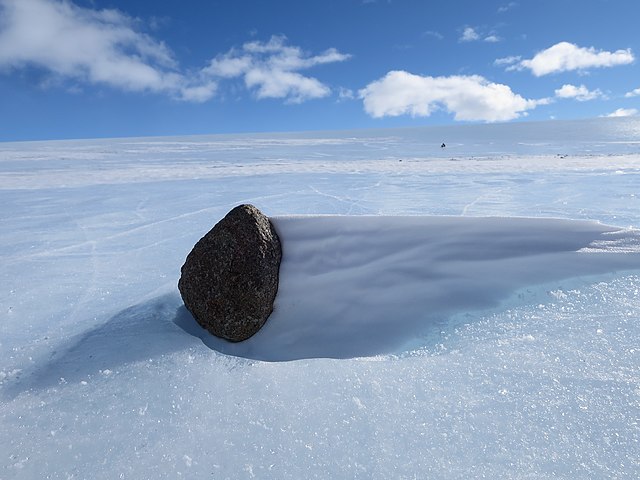
Recent excavations in Antarctica have yielded not just one of the world’s biggest meteorites. The melon-sized rock weighs a staggering 16.7 pounds. It’s thrilling to discover any meteorite, but finding one this large is quite unusual.
Scientists also discovered four additional meteorites and space rocks that were thought to have been brought to Earth by a collision with the ice continent thousands of years ago.
The little collection of meteorites was discovered by scientists on the surface of the Nils Larsen blue ice zone, close to the Princess Elisabeth Antarctica station, which Belgium owns.
Maria Valdes, an expedition scientist and meteoriticist at the Field Museum of Chicago, stated in a news release, “size doesn’t necessarily matter when it comes to meteorites, and even tiny micrometeorites can be incredibly scientifically valuable.”
She further said, “Meteorites themselves are too small to detect from space with satellites. But this study used satellite measurements of surface temperature, surface slope, surface velocity, ice thickness — things like this. And it plugged (the data) into a machine learning algorithm to tell us where the highest probabilities of finding meteorite accumulation zones are.”
Unharmed meteorites
Despite being discovered on the ice’s surface in early January, the meteorites did not fall to Earth very recently. Instead, the space rocks probably spent thousands of years submerged in the ice before being dragged back to the surface by the churning action of glaciers.
Researchers found that the meteorites were completely unharmed since they had been protected from the elements by the ice.
Finding the meteorites was a laborious process even with a known location. According to geochemist and expedition leader Vinciane Debaille of the Free University of Brussels, “the reality on the ground is much more difficult than the beauty of satellite images.”
The group searched a wide region that was littered with rocks that resembled meteorites but were not. Meteor wrongs, which appeared like space rocks but were considerably lighter and originated on Earth, tricked the scientists time and time again.
The first expedition to study potential meteorite hotspots
The 2022 satellite analysis identified many possible meteorite hotspots, and this trip was the first to investigate one of them. Based on their findings, other scientists may be able to utilize the study to help them unearth additional frozen meteorite bits.
Did you know that Antarctica is one of the top spots for meteor hunting? Recently a 16.7 meteorite was recovered! Check it out: 17-pound meteorite discovered in Antarctica — ScienceDaily pic.twitter.com/Wa4GxRkdnQ
— Natalie Zahn (@natalie_HRlady) January 25, 2023
According to the study, there might be up to 300,000 meteorites waiting on the ice’s surface, but only around 15 percent have been found so far. As the mission continues, scientists are crossing their fingers that additional meteorites will be discovered.
“Studying meteorites helps us better understand our place in the universe,” Maria Valdes said. “The bigger a sample size we have of meteorites, the better we can understand our solar system, and the better we can understand ourselves.”
See all the latest news from Greece and the world at Greekreporter.com. Contact our newsroom to report an update or send your story, photos and videos. Follow GR on Google News and subscribe here to our daily email!



